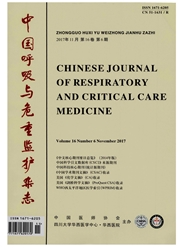

 中文摘要:
中文摘要:
目的分析重症医学科(ICU)收治患者血培养病原菌的菌种分布及耐药性,为重症患者血流感染的预防和控制提供依据。方法回顾性分析2009年1月至2011年12月期间四川大学华西医院ICU收治患者的血培养资料。结果近3年ICU患者送检血培养阳性率分别为15.4%、15.7%和17.6%,分离株以革兰阳性菌为主(52.3%),革兰阴性菌次之(33.1%),真菌最少(14.7%)。细菌分离株中需氧和兼性厌氧菌最多(99.7%)。革兰阳性菌以屎肠球菌和葡萄球菌属为主,屎肠球菌对万古霉素的耐药率为4.5%,金黄葡萄球菌和表皮葡萄球菌对甲氧西林的耐药率分别为73.5%和93.7%。革兰阴性菌中鲍曼/醋酸钙不动杆菌复合体最常见,且96.9%的菌株为多重耐药株,14.1%的菌株为超耐药株;肺炎克雷伯菌和大肠埃希菌较少,其中产生超广谱β-内酰胺酶的菌株分别为70.3%和80.0%。真菌分离株中念珠菌属为主(96.7%),各年份的菌种分布不同,菌株对唑类药物的敏感性出现下降。结论革兰阳性菌应作为预防和控制重症患者血流感染的主要目标,但也应关注由念珠菌和多重耐药革兰阴性菌引起的感染。
 英文摘要:
英文摘要:
Objective To analyze the species distribution and resistance of the pathogens isolated from blood cultures of the patients in intensive care unit(ICU),and provide a basis for prevention and control of bloodstream infections in critically ill patients.Methods The data of blood cultures of the patients in ICU during January 2009 to December 2011 was investigated retrospectively.Results In the last 3 years,positive rate of blood cultures of ICU patients was 15.4%,15.7%,and 17.6% respectively.Among the isolates,Gram-positive bacteria were predominant(52.3%),followed in order by gram-negative bacteria(33.1%) and fungi(14.7%).Aerobe and facultative anaerobe were the predominant bacterial isolates(99.7%).Enterococcus faecium and Staphylococcus spp.were the most common gram-positive bacteria,and 4.5% of E.faecium isolates were resistant to vancomycin.Rate of methicillin-resistance for S.aureus and S.epidermidis was 73.5% and 93.7% respectively.In terms of gram-negative bacteria,Acinetobacter calcoaceticus-A.baumannii complex were the leading species,96.9% of the isolates had multi-drug resistance and 14.1% of the isolates had extra-drug resistance.Klebsiella pneumonia and Escherichia coli isolates were less frequently isolated and those producing extended spectrum beta-lactamases accounted for 70.3% and 80.0% of the isolates respectively.Candida spp.was the most common fungi isolates(96.7%) with an annual change of species distribution and declining susceptibility to azoles.Conclusions Grampositive bacteria should be the major target for prevention and control of bloodstream infections in critically ill patients.Whereas,more attention should be paid to the infection caused by candida spp.and multidrug resistant gram-negative bacteria.
 同期刊论文项目
同期刊论文项目
 同项目期刊论文
同项目期刊论文
 Increasing imipenem resistance and dissemination of the ISAba1-associated bla(OXA-23) gene among Aci
Increasing imipenem resistance and dissemination of the ISAba1-associated bla(OXA-23) gene among Aci 期刊信息
期刊信息
